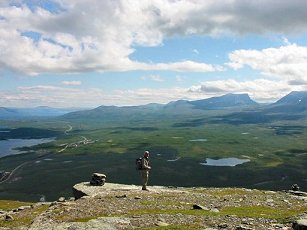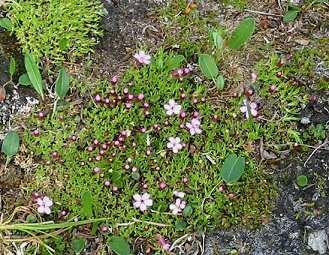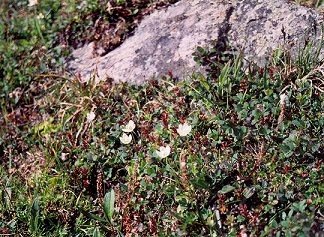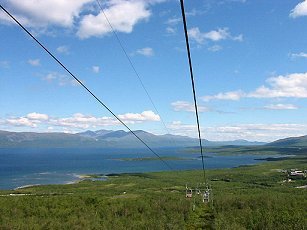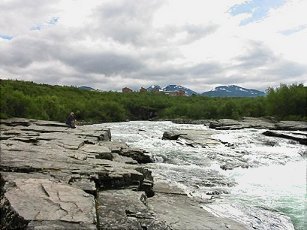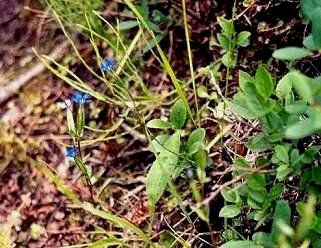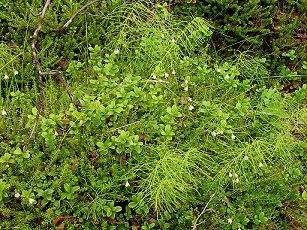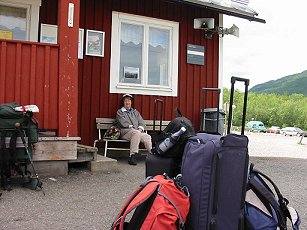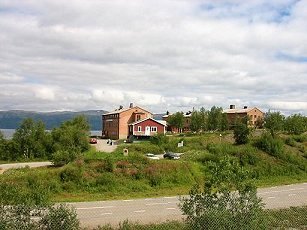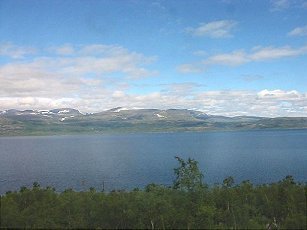Siv & John in northern Lapland - July 2002

View
north over Torneträsk from Nuolja
Abisko - Part 2
For more pictures from Abisko - Part 2, click here
For map of northern Lapland, click here
For map of Abisko and surroundings, click here
So - on our second day in Abisko, we took the
chair lift up on Nuolja, had some warm food in the cabin (with a very
friendly host) at the top of the lift and set out to explore the
mountain side.
We walked south thinking that we would get to the edge of the mountain
where we could overlook the valley. Well, on a mountain the shape of
Nuolja
it's just about impossible to get to what can be considered an
edge. But we had a
wonderful view of Lapporten, the U- shaped pass that
has served as a north-south passage for as long as this country has
been
inhabited, and which has become the unmistakeable emblem for this part
of Lapland.
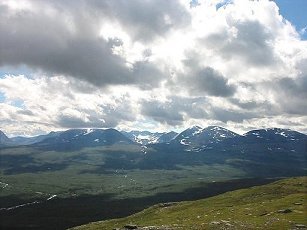 The view was impressive, and the moor we were
walking across was
covered with brightly colored moss
and flowers. We never did get to an 'edge' but the view towards
the south was magnificent with the little stream that trickles through
the valley - most likely to join the Abiskojokk. After realizing that
we were practically on the way to Abiskojaure, the first STF hut on the
way south towards Kebnekajse, we turned and walked in a semi-circle
over
towards the north, following the eastern side. The view over
Torneträsk was impressive. This marvelous lake ranks among the
foremost beauties
of nature in Europe.
The view was impressive, and the moor we were
walking across was
covered with brightly colored moss
and flowers. We never did get to an 'edge' but the view towards
the south was magnificent with the little stream that trickles through
the valley - most likely to join the Abiskojokk. After realizing that
we were practically on the way to Abiskojaure, the first STF hut on the
way south towards Kebnekajse, we turned and walked in a semi-circle
over
towards the north, following the eastern side. The view over
Torneträsk was impressive. This marvelous lake ranks among the
foremost beauties
of nature in Europe.
The area was discovered by tourists already towards the end of the last century, and at the beginning of the 1900's, the tourist station was founded by nature lovers when STF got a
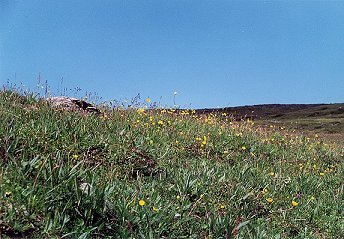 chance to take over the house,
which was abandoned by the railroad workers, after the
work on the Luleå - Narvik railroad was finished.
chance to take over the house,
which was abandoned by the railroad workers, after the
work on the Luleå - Narvik railroad was finished.
 The view was impressive, and the moor we were
walking across was
covered with brightly colored moss
and flowers. We never did get to an 'edge' but the view towards
the south was magnificent with the little stream that trickles through
the valley - most likely to join the Abiskojokk. After realizing that
we were practically on the way to Abiskojaure, the first STF hut on the
way south towards Kebnekajse, we turned and walked in a semi-circle
over
towards the north, following the eastern side. The view over
Torneträsk was impressive. This marvelous lake ranks among the
foremost beauties
of nature in Europe.
The view was impressive, and the moor we were
walking across was
covered with brightly colored moss
and flowers. We never did get to an 'edge' but the view towards
the south was magnificent with the little stream that trickles through
the valley - most likely to join the Abiskojokk. After realizing that
we were practically on the way to Abiskojaure, the first STF hut on the
way south towards Kebnekajse, we turned and walked in a semi-circle
over
towards the north, following the eastern side. The view over
Torneträsk was impressive. This marvelous lake ranks among the
foremost beauties
of nature in Europe.The area was discovered by tourists already towards the end of the last century, and at the beginning of the 1900's, the tourist station was founded by nature lovers when STF got a
 chance to take over the house,
which was abandoned by the railroad workers, after the
work on the Luleå - Narvik railroad was finished.
chance to take over the house,
which was abandoned by the railroad workers, after the
work on the Luleå - Narvik railroad was finished.